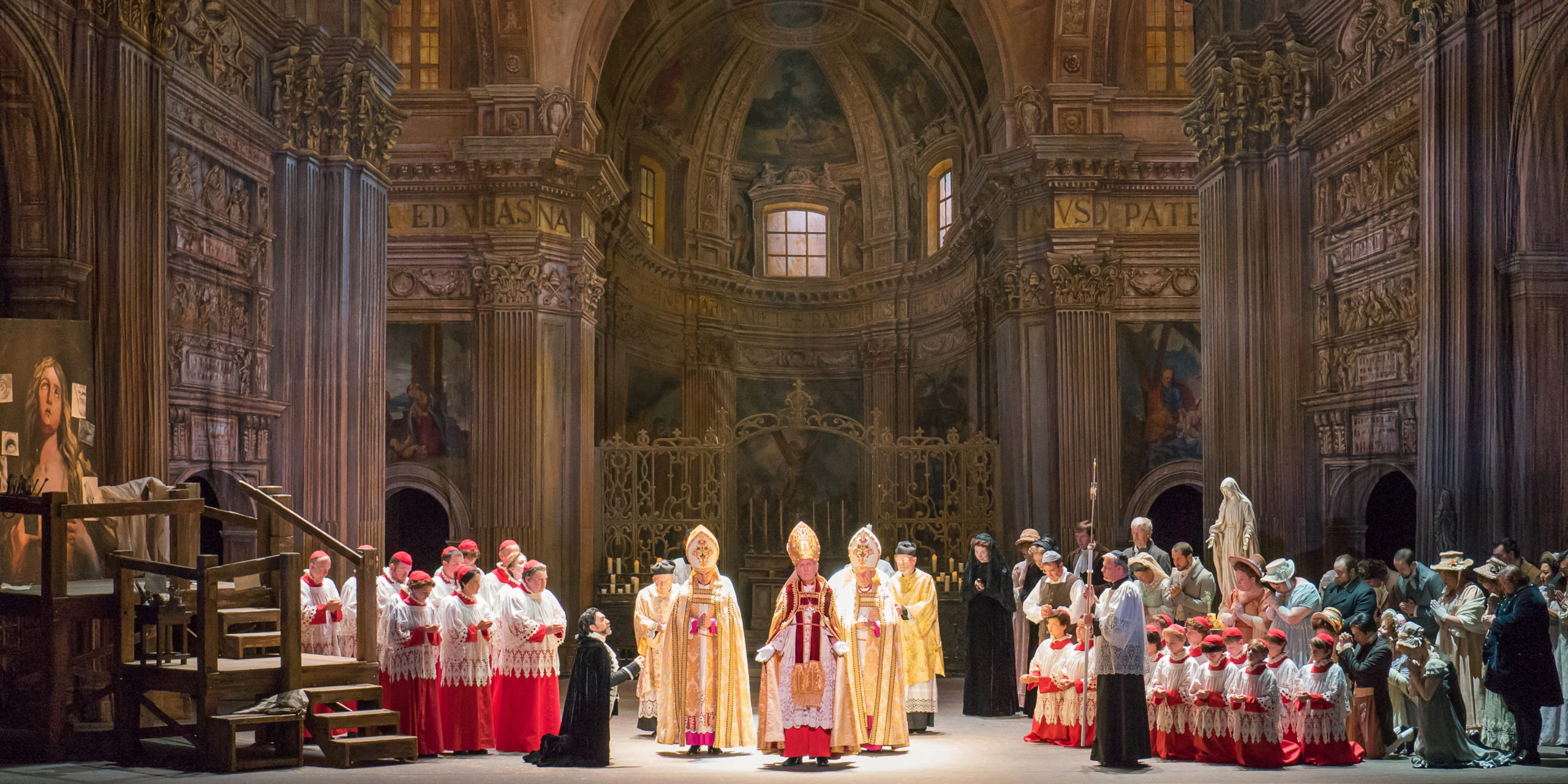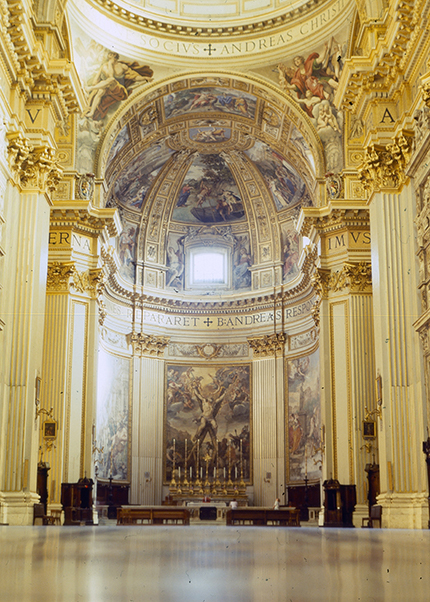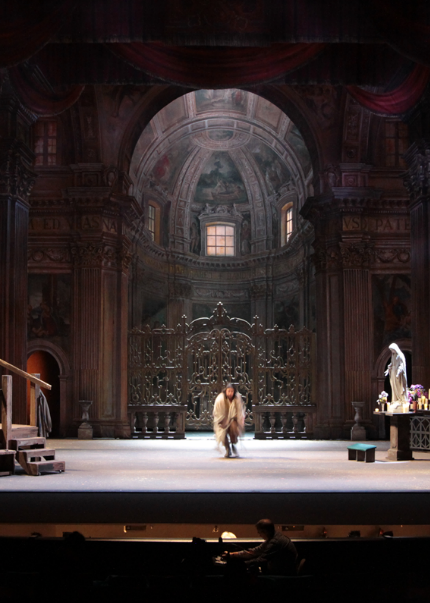Tosca 101 – Setting and Scenery

Photo: Opera Colorado/Matthew Staver
By: Angelica DiIorio and Bethany Wood
Have you ever wanted to visit Italy? Maybe Rome in the summer. How about time travel? Rome in the 1800s sounds refreshing—just watch out for Napoleon and his invading soldiers! Visiting Italy may be possible, but time travel seems a little out of the question. With sets designed to mimic real locations, the closest you can get to Rome in the summer of 1800 is Opera Colorado’s fall 2021 production of Puccini’s Tosca.
Tickets for Puccini’s Tosca start at just $35>>
Who designed the sets?

Ercole Sormani’s set design for Seattle Opera’s 1965 production of “La bohème.”
A focus on detail is at the forefront of this production of Tosca. The sets are designed to bring a sense of realism to the locations and period of the story. Watching this production will make you feel like you are truly there. The sets come from our friends at Seattle Opera, who purchased them in 1969 and conducted a detailed restoration in 2015. The late Ercole Sormani designed these sets. He also created sets for other Puccini classics like La bohème and Madama Butterfly. During his life, Sormani worked in Milan. He studied the perspective painting techniques developed for elaborate wing-and-drop sets. This type of set uses painted muslin cloths hung at varying positions above and alongside the stage to create a sense of vast depth and height extending beyond the dimensions of the theatre space. You can see his mastery of this technique on stage at the Ellie Caulkins Opera House during this November’s production of Tosca.
SANT’ANDREA DELLA VALLE
Much of act one takes place in Sant’Andrea della Valle. It is clear that Sormani studied the church’s interior. You can see the similarities between the architecture of the actual building and the set.
The church was created for the Order of the Theatines, a group of clerics founded to oppose Lutheran doctrines gaining popularity during the Reformation. The construction of Sant’Andrea della Valle lasted from 1591-1665. It involved several Baroque artists and architects, including Giacomo della Porta—a pupil of Michelangelo.

Tosca confronts Cavaradossi as he paints the image of Mary Magdalene.
Political turmoil surrounds the plot of Tosca as well. Rome in the 1800s endured a period of conflict between French, Austrian, Russian, Turkish, and Neapolitan forces as they fought for control of the Italian peninsula. Tosca is set specifically during the Battle of Marengo, a fight between French and Austrian forces on June 14, 1800.
In a private chapel of this church, Cavaradossi, Tosca’s lover, tries to paint Mary Magdalene. It is also where he meets his friend Angelotti, a war prisoner escaping Napoleon. You will see Tosca enter this church and enviously question the muse of Carvaradossi’s painting. It is no wonder the sacristan, the keeper of the chapel, grumbles at all these interruptions.
Interested in learning more about the characters and the plot? Check out our first installment of Tosca 101>>
CASTEL SANT’ANGELO
Act three takes place at the Castel Sant’Angelo or Castle of the Holy Angel, just a fifteen-minute walk north along the Tiber River from the setting of act one. Built in 139 CE for Emperor Hadrian, this papal fortress is one of the oldest buildings in Rome. This building’s big claim-to-fame came towards the end of the sixth century when Pope Gregory received a vision of an archangel returning its sword to the sheath—indicating a plague was over. Sounds like a legitimate story! The tale inspired sculptor Raffaello da Montelupo to create a sculpture of an angel at the top of the church in 1536. When you plan your trip to Rome, be sure to check out the rooftop views. Castel Sant’Angelo offers the city’s best view of St. Peter’s Basilica.
Spoiler alert: Tosca kills Scarpia when he tried to harm her. Rather than turning herself in, she flees to the roof of Castel Sant’Angelo. Tosca decides to take her fate into her own hands. In the final scene, she jumps off the battlement of Castel Sant’Angelo, promising to meet Scarpia before God, to avoid arrest and get her justice in death. Just like Tosca, the angel atop Castel Sant’Angelo looks like it is about to leap off the side into this spectacular view of Rome and Vatican City. The symbolism is not lost as our heroine takes her fall.
Why Make the Sets So Accurate?
But why is this setting so important? For starters, authenticity mattered to Puccini. He went to Castel Sant’Angelo to study the bells at different times of day—talk about dedication. The setting is an integral part of Tosca’s plot. Hopefully, you can see the real thing for yourself one day, but for today, let our production of Tosca take you there.
If you loved learning about these gorgeous pieces of scenery, you deserve to see them live and in person! Tickets for Opera Colorado’s November production of Puccini’s Tosca are on sale now>>
—
Have you been to any of these sights in Rome? Which would you visit first? Let us know if you see the resemblance to these real Roman locations when you come to see Tosca on stage at the Ellie Caulkins Opera House!




